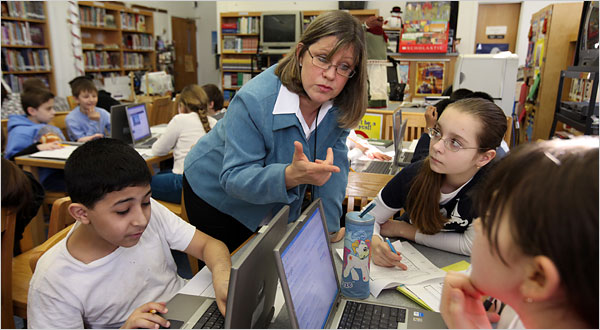Reflection 2 - So it begins
Looking back over my first reflection, I can see I was getting comfortable with some theories
of school librarianship, most specifically the need for an information
search process. Now the readings and assignments seem more entrenched in
the realities of the job, in looking at the particulars of how to transform the theory into a workable reality.
When I took my current position as a media specialist, I had so much to get up to speed on -- meeting the teachers, accessing and maneuvering in the district network, creating lesson plans, learning to use a Smartboard, document camera and on and on -- that I didn’t have much time for big picture thinking of how I wanted the media center to be. But I knew I wanted to move from this:

to this:

James Estrin/The New York Times http://www.nytimes.com/2009/02/16/books/16libr.html?_r=1
And that’s where my library is headed, but I can see that I need to tweak, or in some cases overhaul, my lesson plans, particularly when it comes to teaching kids how to research. The recent course readings on the information search process models like Eisenburg and Berkowitz’s Big6, Stripling and Pitts’s REACTS model, Joyce and Tallman’s I-Search model and more were useful. I like the idea of giving kids a sort of path or template to follow no matter the information need, though I wasn’t sure I could stomach teaching kids one of these process models; it just struck me as too close to a stand alone library skills lesson.
Fortunately, we segued into chapters on constructivist learning and motivating students and inquiry based learning, which dovetails nicely with the open school philosophy of my school. Initially, I wondered how to adapt much of what I was learning to K-6 students, but the information on student’s learning styles and cognitive development helped. For example, I found a sense of relief in studying Piaget’s levels of cognitive development and recognizing that kids under the age of twelve or so tend to be in the preoperational and concrete operational stages, so critical thinking isn’t something they’re completely ready for. That doesn’t mean I won’t try lessons that encourage critical thinking, I’ll just ensure the lessons are more developmentally appropriate.
Bloom’s taxonomy is always useful to revisit, if nothing else to remind me to strive for synthesis and evaluation in the lessons I plan, to move beyond the knowledge and comprehension stages (Thomas, Crow & Franklin, 2011).
In some respects, this class has been a blessing and a curse. I’m being introduced to a variety topics and terms that I think a media specialist should know -- the information search process models, constructivist learning, student motivation and on and on -- and am creating items that I might actually use, such as my WebspirationPRO document that compared two different information search process models (my free month long subscription ran out, so I can’t link to the document, but if you’re interested, you can try it out for yourself here) and a collaboration form. This is all stuff that I can and have used as I develop my media center.
The curse part comes in learning so much and becoming more aware of all that I’m not doing in my media center. At times I find the articles and readings discouraging rather than encouraging, as it seems that I’m so far from being in a place where I can put a lot of these best practices into place. I recognize that it’s a process and in time I’ll become more adept at creating a media center curriculum that hits the standards in an engaging and authentic way, but right now that seems a long way off.
When I took my current position as a media specialist, I had so much to get up to speed on -- meeting the teachers, accessing and maneuvering in the district network, creating lesson plans, learning to use a Smartboard, document camera and on and on -- that I didn’t have much time for big picture thinking of how I wanted the media center to be. But I knew I wanted to move from this:
to this:
James Estrin/The New York Times http://www.nytimes.com/2009/02/16/books/16libr.html?_r=1
And that’s where my library is headed, but I can see that I need to tweak, or in some cases overhaul, my lesson plans, particularly when it comes to teaching kids how to research. The recent course readings on the information search process models like Eisenburg and Berkowitz’s Big6, Stripling and Pitts’s REACTS model, Joyce and Tallman’s I-Search model and more were useful. I like the idea of giving kids a sort of path or template to follow no matter the information need, though I wasn’t sure I could stomach teaching kids one of these process models; it just struck me as too close to a stand alone library skills lesson.
Fortunately, we segued into chapters on constructivist learning and motivating students and inquiry based learning, which dovetails nicely with the open school philosophy of my school. Initially, I wondered how to adapt much of what I was learning to K-6 students, but the information on student’s learning styles and cognitive development helped. For example, I found a sense of relief in studying Piaget’s levels of cognitive development and recognizing that kids under the age of twelve or so tend to be in the preoperational and concrete operational stages, so critical thinking isn’t something they’re completely ready for. That doesn’t mean I won’t try lessons that encourage critical thinking, I’ll just ensure the lessons are more developmentally appropriate.
Bloom’s taxonomy is always useful to revisit, if nothing else to remind me to strive for synthesis and evaluation in the lessons I plan, to move beyond the knowledge and comprehension stages (Thomas, Crow & Franklin, 2011).
In some respects, this class has been a blessing and a curse. I’m being introduced to a variety topics and terms that I think a media specialist should know -- the information search process models, constructivist learning, student motivation and on and on -- and am creating items that I might actually use, such as my WebspirationPRO document that compared two different information search process models (my free month long subscription ran out, so I can’t link to the document, but if you’re interested, you can try it out for yourself here) and a collaboration form. This is all stuff that I can and have used as I develop my media center.
The curse part comes in learning so much and becoming more aware of all that I’m not doing in my media center. At times I find the articles and readings discouraging rather than encouraging, as it seems that I’m so far from being in a place where I can put a lot of these best practices into place. I recognize that it’s a process and in time I’ll become more adept at creating a media center curriculum that hits the standards in an engaging and authentic way, but right now that seems a long way off.
Comments
Post a Comment